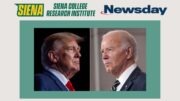Corruption – A Serious Problem – Has Not Gotten Worse Over Last Few Years, Voters Say; Not As Important as Jobs or Education as Priority Issue for Legislature to Address
Voters Strongly Support Continuing Property Tax Cap (Maybe with Changes); Support Start-Up NY; Continue to Support SAFE Act; Voters Divided on Education Tax Credit and Dream Act
Cuomo Favorability & Job Performance Ratings Worst As Governor
Loudonville, NY. While 90 percent of voters say corruption in state government is a serious problem and 62 percent say corruption among their state legislators is a serious problem, 57 percent say the level of corruption in state government over the last four years is about the same as it was previously. However, addressing corruption and ethics is a second tier issue for voters, who say the top two issues for the Legislature to address are jobs and education, according to a new Siena College poll of New York State registered voters released today.
More than three-quarters of voters want to see the property tax cap continued – 43 percent as is; 36 percent with changes to give school districts and local governments more flexibility. Voters support the Start-Up New York program 52-37 percent and the SAFE Act 62-33 percent (up slightly from 58-33 percent in December). Voters are split on the proposed education tax credit plan – with 44 percent supporting it and 49 percent opposing – and the Dream Act, which is supported by 47 percent and opposed by 50 percent (44-50 percent last month). Governor Andrew Cuomo now has his lowest favorability and job performance ratings since taking office.
“Voters continue to see corruption in state government as a serious issue, with half saying it’s a very serious issue. One-third of voters think there’s been more corruption in the last four years than there was previously, however, a clear majority, 57 percent, say it’s about the same as it previously was,” said Siena College pollster Steven Greenberg. “By a 55-35 percent margin – including majorities from every party and region – voters say the recent indictments of former Speaker Sheldon Silver and former Majority Leader Dean Skelos will not reduce corruption in Albany.
“When it comes to reducing corruption, half – including a majority of Democrats and those from New York City – say Cuomo has been at least somewhat effective, while half say he has not been,” Greenberg said.
Jobs/economy was identified by 30 percent of voters as the most important issue they want their state legislators working on, followed by education at 27 percent, corruption and ethics at 15 percent, taxes at 13 percent and health care at 12 percent.
“While voters see corruption as a serious problem in Albany, it is certainly not the most important issue they want the Legislature to address,” Greenberg said. “Jobs and education are the key issues for all voters. Jobs leads the way with Republicans and independents, New York City and upstate voters, and those 55 and older. Democrats are split between education and jobs as the top issue, while education tops the list for downstate suburbanites and voters under 55.
“If Albany does try to address the corruption issue before session ends, voters think there are several reforms that would help reduce corruption, however, they are closely divided on which would be the most effective in reducing corruption,” Greenberg said. “One-third say dramatically reducing campaign contribution limits, while one-quarter each say true independent oversight and increased financial disclosure are the way to go. Only one in eight think a full time legislature is the most effective corruption fighting proposal.
“Nearly three-quarters of voters – including at least two-thirds from every party and region – say that recent arrests and corruption scandals make them more likely to vote next year to ‘be part of the solution,’ compared to only 16 percent who say they are less likely to vote since ‘state government is hopelessly corrupt.’ And while 37 percent of voters say all the scandals make them less likely to vote for their incumbent legislators, 11 percent say it makes them more likely and about half say the scandals have no effect on their vote next year,” Greenberg said.
Voters Want Property Tax Cap Continued – Many Want Some Changes – Few Want it Eliminated
Nearly three-quarters of voters agree with tax cap supporters that taxpayers are not seeing large increases as they previously had, and only 41 percent agree with opponents that the cap has forced local governments and school districts to cut services. Forty-three percent of voters say continue the cap as is, 36 percent say continue the cap but provide school districts and local governments a little more flexibility, and 17 percent say eliminate the cap.
“Democrats and Republicans, upstaters and downstaters agree that the property tax cap should be continued,” Greenberg said. “The property tax cap had broad, statewide, bi-partisan support when it was passed four years ago and it continues to be an issue that garners support from the vast majority of New Yorkers.”
Support for Start-Up New York; Particularly from Downstaters and Democrats
“With millions spent on advertising the Start-Up New York program, about half of New Yorkers say they have heard or read at least something about it,” Greenberg said. “Among all voters, support for Start-Up New York is 52-37 percent, however, there are clear partisan and geographical differences. Democrats support the program better than two-to-one, as do New York City voters. It also has solid support from downstate suburbanites. Upstaters and independents are closely divided, while a small majority of Republicans oppose the program.”
SAFE Act Continues to Enjoy Strong Support
“Views on the SAFE Act have remained largely unchanged over time. It has the support of more than three-quarters of Democrats and New York City voters and a strong majority of independents and downstate suburbanites. Upstaters are closely divided, with a bare majority opposed and Republicans are strongly opposed,” Greenberg said. “While three-quarters of those who view Cuomo favorably support the SAFE Act, only a bare majority of those who view him unfavorably are opposed.”
Education Tax Credit Proposal and Dream Act Both Closely Divide Voters
Voters were told that the education tax credit proposal has three key provisions and were given arguments in support, including the support of Cuomo and Cardinal Timothy Dolan, and opposition, including the opposition of teachers’ unions. It is supported by 44 percent of voters and opposed by 49 percent.
“The education tax credit proposal divides voters – but not on a partisan basis. Opposition beats out support by four points among Democrats and Republicans, and by 10 points among independents. New York City voters support it by a 14-point margin and downstate suburbanites oppose it by a nine-point margin, as upstaters give it a solid thumbs down, 58-34 percent,” Greenberg said. “While white voters oppose the proposal, it is supported by a majority of black, Latino, Jewish, and Catholic voters. It is strongly opposed by those earning more than $100,000 annually and supported by those earning less than $50,000. And those in households with at least one union member oppose it two-to-one.
“The Dream Act continues to divide voters. While it is supported by at least 62 percent of Democrats, New York City voters, blacks, Latinos and voters under 35, it is opposed by more than three-quarters of Republicans, a majority of independents, strong majorities of downstate suburbanites and upstaters, white voters and those 55 and older,” Greenberg said.
Cuomo Favorability & Job Performance Ratings Hit Low Point in Five Years as Governor
Cuomo’s favorability rating is 53-44 percent, down from 56-39 percent last month and 63-31 percent in June 2014. He has a negative 41-59 percent job performance rating, down from a negative 44-55 percent last month and 49-50 percent in June 2014.
“Cuomo, while still viewed favorably by a small majority of voters, has his lowest favorability rating since he’s been governor. While his statewide favorability rating dropped by a net eight points in the last month, it fell by a net 19 points with New York City voters and a net 25 points with Republicans,” Greenberg said. “Similarly, Cuomo’s job performance rating is also at an all-time low. More than twice as many voters say he’s doing a poor job as compared to those who say he’s doing an excellent job. Even Democrats are evenly divided, with 50 percent giving him a positive job performance rating and 49 percent rating him negatively. His job performance rating is significantly under water with Republicans, independents, downstate suburbanites and upstaters.”
Assembly Favorability Rating Up, Near Even; While Senate Favorability Drops A Bit
The State Assembly’s favorability rating is 43-46 percent, up from 38-49 percent last month, and Speaker Carl Heastie has a 12-16 percent favorability rating, up a little from 11-19 percent last month. The State Senate’s favorability rating is 41-49 percent down slightly from 42-48 percent last month. Former Majority Leader Dean Skelos has a 13-40 percent favorability rating, down significantly from 12-28 percent last month. New Majority Leader John Flanagan has 17-14 percent favorability rating.
“While the Senate saw a slight dip in its favorability rating and the Governor’s favorability rating dropped, as did the mood of voters on the direction of the state, the Assembly saw a rebound in its favorability rating,” Greenberg said. “Skelos is more known than he’s ever been but he’s also viewed more unfavorably than he has ever been, although his unfavorability rating does not approach that of former Speaker Sheldon Silver’s 58 percent the month after he was indicted.”
# # #
This Siena College Poll was conducted May 18-21, 2015 by telephone calls conducted in English to 695 New York State registered voters. Respondent sampling was initiated by asking for the youngest male in the household. It has an overall margin of error of +/- 3.7 percentage points including the design effects resulting from weighting. Sampling was conducted via a stratified dual frame probability sample provided by Survey Sampling International of landline and cell phone telephone numbers from within New York State weighted to reflect known population patterns. Data was statistically adjusted by age, party, region and gender to ensure representativeness. The Siena College Research Institute, directed by Donald Levy, Ph.D., conducts political, economic, social and cultural research primarily in NYS. SRI, an independent, non-partisan research institute, subscribes to the American Association of Public Opinion Research Code of Professional Ethics and Practices. For more information, call Steve Greenberg at (518) 469-9858. For survey cross-tabs: www.Siena.edu/SRI/SNY.





